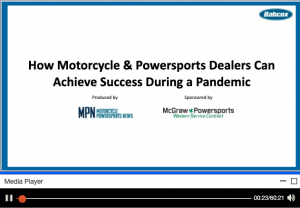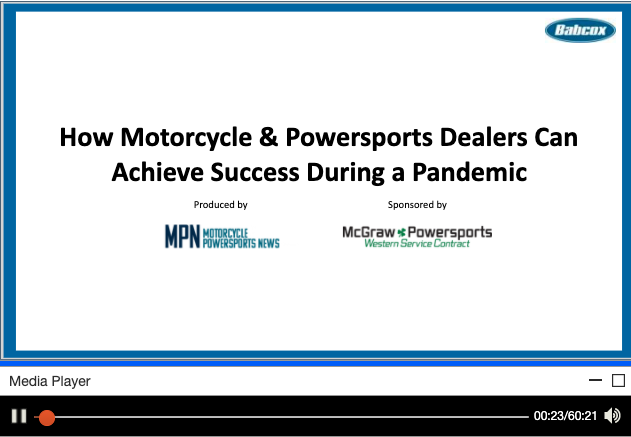 Industry experts Gart Sutton and Jason Duncan led us through an educational journey on Thursday, August 13th moderated by Motorcycle & Powersports News’ Amy Szymanski discussing how dealers can achieve success during a pandemic. They expanded on industry trends, safety, non-negotiables, and just navigating through this new norm. The speakers began by acknowledging that we are in uncharted waters with forecasting today. When the unforeseen happens, it makes predicting future trends and sales awfully difficult. However, the powersport industry has seen an upswing and sales of vehicles during this age of social distancing has gradually increased.
Industry experts Gart Sutton and Jason Duncan led us through an educational journey on Thursday, August 13th moderated by Motorcycle & Powersports News’ Amy Szymanski discussing how dealers can achieve success during a pandemic. They expanded on industry trends, safety, non-negotiables, and just navigating through this new norm. The speakers began by acknowledging that we are in uncharted waters with forecasting today. When the unforeseen happens, it makes predicting future trends and sales awfully difficult. However, the powersport industry has seen an upswing and sales of vehicles during this age of social distancing has gradually increased.
Gart Sutton, F&I expert, kicked off the webinar by going over the benchmark of gross profits, which is the overall number resulting from sales minus cost-of-sales minus concessions. There has been a huge spike in contract sales since dealers are selling so many units and now there’s a supply issue. Margins right now should be better considering the demand. If inventory is short, dealers need to pay attention to holding those margins because we are not sure what inventory will look like in the future given the current state of the pandemic. He also reminded the participating dealers to make sure that they are always including the expenses of the dealership. Overhead needs to be built into gross profit numbers into that 15 cents on the dollar figure.
The conversation then tackled the preowned market as Jason and Gart touched on how preowned units have the ability for higher gross profit, approximately 20 cents on the dollar. Even considering this, dealers are switching gears and are hitting alternative selling avenues like Facebook marketplace and Craigslist to sell their preowned inventory. It’s kind of the perfect storm because as the new inventory is dwindling, preowned, which is usually very lucrative, becomes the default but ultimately dealerships need those premium units.
Throughout the discussion, the two panelists were making sure to include their best tips and tricks like using a Finance & Insurance menu. This is the best way to showcase all the products all the time and to stick to compliance issues which are always out there. The benchmark for the F&I department is calculated by dividing the gross profit by the total new/used units results in the F&I per vehicle sold and the resulting number will fall somewhere between $450-$1000. There is a huge variance in that number.
“The number one factor that I see that influences the overall average is what a finance manager is charging for a contract. You have to find a fair balance of what you’re going to make and what’s a good value for the customer,” says Duncan.
During the webinar, they also discussed a question regarding shifting from a cradle to grave sales approach and if that would be beneficial at the moment. This means trying to convince people that there’s really no good time to buy so they might as well buy now. Jason explained that the way consumers are purchasing powersports right now, they definitely need to understand that if they are looking at a vehicle then it is also something others are probably also looking at so there is a certain sense of urgency given that product is flying off the showroom floor. Gart further explained that this is a golden opportunity to sell more F&I because of all of the uncertainties surrounding the times.
The conversation then transitioned to word tracks. Think of cash conversion word tracks as a tool box that tells you what to say under any circumstance.
“Be prepared and know what to say!” – Gart Sutton
Per unit averages are down because people have additional free cash because of one reason or another and are redirecting this to the purchase of a powersport vehicle. When someone uses cash, they do not consider anything other than the unit they are buying. It is this “I know what I want and I am going to pay for it down to the last cent” mentality so that they don’t have to deal with a payment plan. All cash is fine but, as we know, dealer payment plans and backend sales rely on financial flexibility. As a dealer, you do not necessarily need to be hard pressed to convert the person from using all cash but you can defer it and ask them to take some time to consider doing a cash conversion so that they can consider the options.
The most important thing is to confirm the cash. You ask if the cash is from the customer’s checking or savings or if they will be borrowing the money. If they can convincingly say that it is real, upfront cash and they can write a check then the word track can continue. This needs to be verified. The next step is to ask the customer if you can share what other cash customers are doing lately. This is a very soft sale approach, making the customer feel comfortable while paperwork is being completed. This is the time to use to make some small talk, solidify your rapport with the individual and then TRY (key word: try because you won’t always be successful) to pitch an alternative payment plan. Once you have permission for the customer to continue the conversation, you can ask why they paid with cash in a genuine, inquisitive manner and then ask if it is security or convenience that motivates them to purchase a big ticket item like this with cash. This will give you an idea if the customer could be unreliable in terms of payments or credit. The next step is weighing the advantages of dealership financing versus paying in cash. A dealer plan offers many more benefits to a cash payment like savings protection, forced savings, greater liquidity, flexibility of paying it off whenever the customer wants, establishing or maintaining credit standing, and hedges inflation. These are all aspects of the dealer plan to explain and offer to the customer and hopefully you will be able to convert even a small percentage of the all-cash customers.
Another question arose about how to better market a dealership during the pandemic by highlighting that proper precautions are being put into place in terms of sanitization and mask requirements. To this, they responded that it is important to have proper signage indicating that it is a safe, clean area. It would even be important to outline the exact protocols you are following as a dealership to put customers at ease. The ultimate goal is to make your customers as comfortable as possible. Think of it as another opportunity to market yourself as well. For example, dealers who are wearing face masks can customize them to contain verbiage marketing another aspect of their business thus making the mask a tool for more potential sales. THIS is how to make lemonade out of lemons and this kind of innovative thinking sets apart the good dealers from the great dealers.
It is always important to go back to your financial source to make sure you are able to offer your customer the best possible deal. When it comes to F&I products, extended service coverage seems to be the most popular backend product to sell. There are some other F&I department non-negotiables and these include:
1) All customers are introduced to the Business (F&I) Office at the point-of-sale. There are no exceptions.
2) Salespeople refer to customer questions about rates, exact payments or insurance programs to the Business (F&I) Manager.
3) Follow the 400% rule: 100% of customers are offered 100% of our F&I products…100% of the time with 100% compliance.
4) Use a Finance & Insurance MENU without exception.
5) Business Manager never accepts a decline/rejection from the preferred lender without qualifications.
One final question came in about how to sell F&I products when customers are not even coming into the dealership to purchase their vehicles. This is an interesting predicament but you can always pick up the phone and call to let them know about their options. There is no harm in doing this and these products only benefit them protecting their investment and their own finances. A zoom call is also an option if you want a more face-to-face interaction.
Jason and Gart managed to fit a lot of really useful knowledge into 60 minutes of airtime and we are proud to be able to summarize and share this information with you.
If you have any follow-up questions for Jason Duncan, please email him at jduncan@mcgrawpowersports.com.
*Any content at this training or in this summary, whether provided by McGraw or its Presenters, is presented for educational, general reference and informational purposes only. It is not intended to serve as financial, legal or other advice and is not intended to be a full and exhaustive explanation of the content. It should not be used to replace the advice of your own advisors, consultants or counsel. McGraw makes no representation or warranty that the content is accurate, complete or current for any specific or particular purpose or application.

